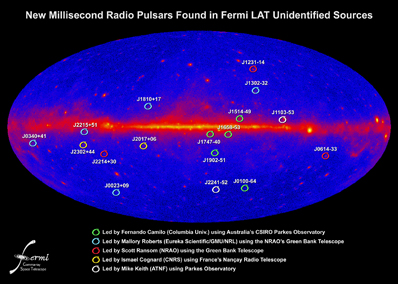


|

|
 |
|
Could super-fast pulsars act as gravity wave detectors? KEITH COOPER ASTRONOMY NOW Posted: 06 January 2010 An unprecedented haul of 17 cosmic whirling dervishes – pulsars that spin thousands of times per second – is providing a boost for research into these extraordinary objects, and may even be the key to detecting something even more extraordinary: gravitational waves. The 17 millisecond pulsars have been found courtesy of NASA’s Fermi Space Telescope, which observes gamma-ray radiation from particles that have been accelerated in the powerful magnetic fields belonging to the pulsars. Fermi identifies them as unknown high energy sources, which are then followed up on by radio telescopes on Earth. The first millisecond pulsar was discovered in 1982, and between then and Fermi’s latest findings, only 60 had been discovered in the Milky Way.  Locations of the new millisecond pulsars. Image: NASA/DOE/Fermi LAT Collaboration. Locations of the new millisecond pulsars. Image: NASA/DOE/Fermi LAT Collaboration.
“Locating them with all-sky radio surveys requires immense time an effort, and we’ve only found a total of about 60 in the disc of our galaxy since then,” says Paul Ray of the Naval Research Lab in Washington, DC. “Fermi points us to specific targets. It is like having a treasure map.” Pulsars are spinning neutron stars, which are the remains of a massive star that has exploded as a supernova. As they spin, beams of radio waves emanating flash in our direction, causing them to appear to pulse, hence their name. Neutron stars are born spinning, but over time they slow down. However, those located in a binary system with another star can find themselves rejuvenated. In these circumstances, the gravity of the extremely dense neutron star can strip gas from its companion, and this process sees the pulsar spun up, a bit like a spinning top, to the point that it spins thousands of times per second (for more on millisecond pulsars see our recent news story here). This helping hand from the companion star is not always reciprocated. Four of the 17 new pulsars are known as black widow pulsars, because their radiation is eating away at the very companion star that span them up in the first place, to the point that the companions have been whittled down to just a few dozen times the mass of the planet Jupiter. For us on Earth, they may provide surprising benefits. Pulsars ‘pulse’ with incredible regularity – they are the most precise time-keepers in the Universe. Suppose an elusive gravitational wave, perhaps created by a black hole or neutron star merger, passed this way; any disruption in the pulsing signals from a group of precisely measured millisecond pulsars caused by the gravitational wave would be a dead giveaway. To watch a NASA animation of a millisecond pulsar being spun up, click here. |
|
|
|
|